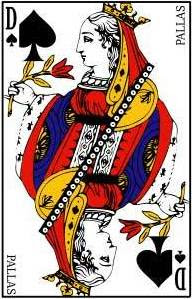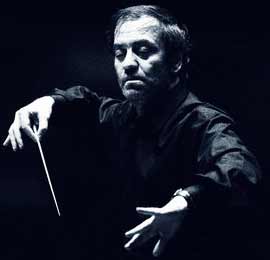The annual visit of the Mariinsky Theater's traveling troupe from St. Petersburg, being billed as "Kirov at Kennedy" on promotional posters, came a little early this year, with two staged operas but no concert performance. The themes that unite the Kennedy Center double-bill of Verdi's Otello and Tchaikovsky's Queen of Spades are self-destructive obsessions ("Three! Seven! Ace!" and "Il fazzoletto!") and tenor heroes who become villains. The other similarity is that in both operas, premiered in 1887 and 1890, the composers have learned the lessons provided by Richard Wagner. While Tchaikovsky's orchestral works, especially the concerti, can be syrupy and repetitive, his strongest contributions are in opera and the song. Among the operas, we have recently admired Eugene Onegin, The Maid of Orléans, Iolanta, and Mazeppa, but there are a couple on the composer's works list that we have yet to see produced (Cherevichki or The Sorceress, anyone?).
The Queen of Spades may be Tchaikovsky's most popular and often-produced opera, but other than an excerpt from Dmitri Hvorostovsky recently, there have been no live performances reviewed at Ionarts (although Washington National Opera has mounted it in 1989 and 2002). Who better to perform it than musicians from St. Petersburg's Mariinsky Theater, which hosted the world premiere of The Queen of Spades on December 19, 1890? The opera is thoroughly Russian, with a libretto based on a classic story by Aleksandr Pushkin, Пиковая дама (The Queen of Spades, trans. Natalie Duddington or H. Twitchell). The libretto (see this synopsis for details) moves the setting back to the St. Petersburg of the late 18th century, which this 1999 production directed by Alexander Galibin mostly maintained.
 Right from the opening, the conflict of good and evil was set forth by the swirling curtains that dominated the sparsely furnished stage (sets by Alexander Orlov). Black curtains were peeled back to reveal white ones, and vice versa, stretching from one side of the stage, with a black set piece, to a white piece on the other. The brooding Hermann was costumed in stark black, as is the old countess moved about in her wheelchair, again contrasting with the white costume in which Lisa first appeared, only to be corrupted to black in later acts (costumes by Irina Cherednikova). Streaks of color washed the stage at other points, as during the dance scenes, especially the vivid green of the pastoral entertainment in the second act.
Right from the opening, the conflict of good and evil was set forth by the swirling curtains that dominated the sparsely furnished stage (sets by Alexander Orlov). Black curtains were peeled back to reveal white ones, and vice versa, stretching from one side of the stage, with a black set piece, to a white piece on the other. The brooding Hermann was costumed in stark black, as is the old countess moved about in her wheelchair, again contrasting with the white costume in which Lisa first appeared, only to be corrupted to black in later acts (costumes by Irina Cherednikova). Streaks of color washed the stage at other points, as during the dance scenes, especially the vivid green of the pastoral entertainment in the second act.
A mysterious supernumerary lady in a yellow dress and mask, the silhouette of the young Countess now known as the Queen of Spades, hovered in the background, statue-like. A plain staircase at the back of the stage, in front of the projection screen of clouds or sky, doubled as seating for the guests, while the curtains provided settings that imply other rooms or spaces. The production's starkness was its appeal, although rarely the stage's emptiness seemed more like economy than minimalism. For example, in the gambling scene of the third act, without even a table to throw cards on, the male chorus often seemed to move about aimlessly, and one missed the spinet Lisa is supposed to play on in Act I.
In the second cast, heard on Tuesday night, Maxim Aksenov was a dashing and aloof Hermann, a believably intense loner. When he loses everything at cards in Act III, duped by the Countess's ghost into "betting the turn" (the ultra-risky bet on the final three cards in faro, which if guessed correctly could quadruple your money), his crazed despair was palpable. Aksenov's throaty but full voice had sustainable power and incisive high notes, and he was mostly up to the demanding role, conceived for the Russian tenor Nikolay Figner, almost always on stage and singing in every scene. As Lisa, Natalia Tymchenko cut a lovely figure but acted stiffly, and her voice sounded slightly strained at times, as in crucial moments during "Why these tears" (Откуда эти слезы) in Act I. Veteran mezzo-soprano Irina Bogacheva was superlative as the Countess, with a marbled, husky voice and a magnetic stage presence even while seated in her wheelchair. Of the supporting roles, all of them generally strong, Evgeny Nikitin stood out as Tomsky for his resonant bass, as did Vladislav Sulimsky's Prince Yeletsky, mostly for the moving aria "I love you beyond measure" (Я вас люблю) in Act II.
 The Kirov Opera's traveling orchestra was in admirable form, as was the chorus, especially the men in the final gambling scene. At the podium, Valery Gergiev gave the unstoppable energy we have come to expect from him, somewhat unreasonably. The Kennedy Center performances are scheduled on his days off from his other conducting gig at the moment, Prokofiev's War and Peace at the Met, which means the exhausting routine of shuttling back and forth to New York. (He was there on Monday night and again this evening, after Queen of Spades and Otello here on Tuesday and Wednesday.) Gergiev led his players in creating a sublime orchestral fabric, calibrated generally well to the strengths of his singers and occasionally blowing the roof off the joint, as in the thrilling storm scene in Act I. The volume was certainly there in the patriotic imperial chorus, too, for the supposed appearance of Catherine the Great in Act II, but here Gergiev's enthusiasm seemed to cause a few misalignments of ensemble. Still, minor quibbles aside, this was a most enjoyable way to hear Tchaikovsky.
The Kirov Opera's traveling orchestra was in admirable form, as was the chorus, especially the men in the final gambling scene. At the podium, Valery Gergiev gave the unstoppable energy we have come to expect from him, somewhat unreasonably. The Kennedy Center performances are scheduled on his days off from his other conducting gig at the moment, Prokofiev's War and Peace at the Met, which means the exhausting routine of shuttling back and forth to New York. (He was there on Monday night and again this evening, after Queen of Spades and Otello here on Tuesday and Wednesday.) Gergiev led his players in creating a sublime orchestral fabric, calibrated generally well to the strengths of his singers and occasionally blowing the roof off the joint, as in the thrilling storm scene in Act I. The volume was certainly there in the patriotic imperial chorus, too, for the supposed appearance of Catherine the Great in Act II, but here Gergiev's enthusiasm seemed to cause a few misalignments of ensemble. Still, minor quibbles aside, this was a most enjoyable way to hear Tchaikovsky.
The final chance to hear the Kirov Opera's Queen of Spades is on Friday night (December 14, 7:30 pm), with the much-praised first-cast pairing of Vladimir Galouzine and Mlada Khudoley. A review of Otello is forthcoming, but this is the opera to see if you can only go to one or the other.
 Right from the opening, the conflict of good and evil was set forth by the swirling curtains that dominated the sparsely furnished stage (sets by Alexander Orlov). Black curtains were peeled back to reveal white ones, and vice versa, stretching from one side of the stage, with a black set piece, to a white piece on the other. The brooding Hermann was costumed in stark black, as is the old countess moved about in her wheelchair, again contrasting with the white costume in which Lisa first appeared, only to be corrupted to black in later acts (costumes by Irina Cherednikova). Streaks of color washed the stage at other points, as during the dance scenes, especially the vivid green of the pastoral entertainment in the second act.
Right from the opening, the conflict of good and evil was set forth by the swirling curtains that dominated the sparsely furnished stage (sets by Alexander Orlov). Black curtains were peeled back to reveal white ones, and vice versa, stretching from one side of the stage, with a black set piece, to a white piece on the other. The brooding Hermann was costumed in stark black, as is the old countess moved about in her wheelchair, again contrasting with the white costume in which Lisa first appeared, only to be corrupted to black in later acts (costumes by Irina Cherednikova). Streaks of color washed the stage at other points, as during the dance scenes, especially the vivid green of the pastoral entertainment in the second act. The Kirov Opera's traveling orchestra was in admirable form, as was the chorus, especially the men in the final gambling scene. At the podium, Valery Gergiev gave the unstoppable energy we have come to expect from him, somewhat unreasonably. The Kennedy Center performances are scheduled on his days off from his other conducting gig at the moment, Prokofiev's War and Peace at the Met, which means the exhausting routine of shuttling back and forth to New York. (He was there on Monday night and again this evening, after Queen of Spades and Otello here on Tuesday and Wednesday.) Gergiev led his players in creating a sublime orchestral fabric, calibrated generally well to the strengths of his singers and occasionally blowing the roof off the joint, as in the thrilling storm scene in Act I. The volume was certainly there in the patriotic imperial chorus, too, for the supposed appearance of Catherine the Great in Act II, but here Gergiev's enthusiasm seemed to cause a few misalignments of ensemble. Still, minor quibbles aside, this was a most enjoyable way to hear Tchaikovsky.
The Kirov Opera's traveling orchestra was in admirable form, as was the chorus, especially the men in the final gambling scene. At the podium, Valery Gergiev gave the unstoppable energy we have come to expect from him, somewhat unreasonably. The Kennedy Center performances are scheduled on his days off from his other conducting gig at the moment, Prokofiev's War and Peace at the Met, which means the exhausting routine of shuttling back and forth to New York. (He was there on Monday night and again this evening, after Queen of Spades and Otello here on Tuesday and Wednesday.) Gergiev led his players in creating a sublime orchestral fabric, calibrated generally well to the strengths of his singers and occasionally blowing the roof off the joint, as in the thrilling storm scene in Act I. The volume was certainly there in the patriotic imperial chorus, too, for the supposed appearance of Catherine the Great in Act II, but here Gergiev's enthusiasm seemed to cause a few misalignments of ensemble. Still, minor quibbles aside, this was a most enjoyable way to hear Tchaikovsky.




















































1 comment:
The Mariinsky Opera Theater visiting productions of Khovanshchina and Mazeppa (as well as the visually stunning MacBeth) were also all highly memorable events at the Kennedy Center (as was one of the great pageant scenes from Rimsky-Korsakov's Sadko, featured at the Kirov sampler).
I can also recommend the Mariinsky Theater productions of Rimsky-Korsakov's The Legend of the Invisible City of Kitezh and the Maiden Fevroniya and Prokofiev's Semyon Kotko; both of which have already been performed at the MET Opera House to rave reviews (in 2003).
I hope that the Mariinsky will bring these two productions to the Kennedy Center before the 10 year, one-way cultural exchange program ends in a few years time.
Post a Comment